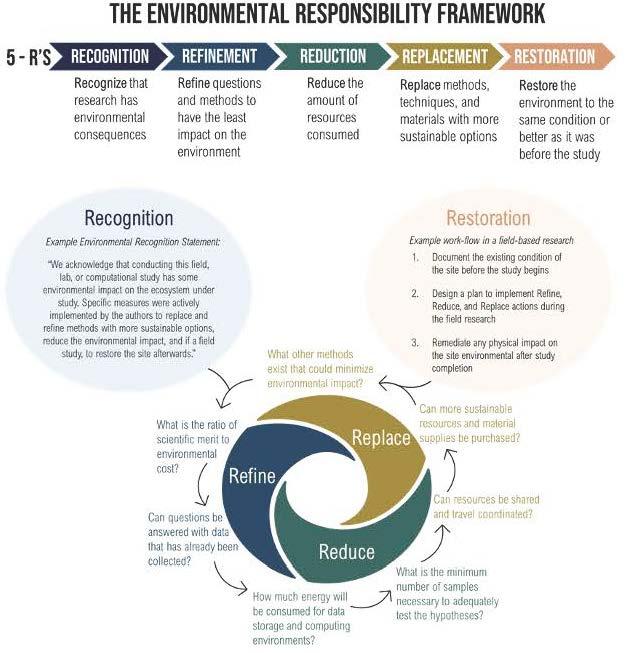Hydroinformatics Blog - A framework for conducting environmentally-responsible hydroinformatics research
Posted Jul 11, 2023
Hydroinformatics Blog Post
Organized by the CUAHSI Informatics Standing Committee. Contributions are welcome, please contact Veronica Sosa Gonzalez at email hidden; JavaScript is required.
By: Desneiges (Deni) Murray
Scientific research, whether conducted in the field and laboratory, or using computational approaches, inevitably has an environmental impact through fossil fuel emissions, energy consumption, and the use of computing and data storage facilities.
As scientists studying the environment, we are acutely aware of the environmental challenges facing the world today. However, our scientific methods themselves contribute to this impact, and we encounter this irony daily. For example, we use plastic bottles (sometimes single-use) to collect water samples for studying plastic pollution, we travel long distances in diesel trucks to collect samples and study environments affected by climate variability and change, and we rely on coal-based energy to fuel computational resources to run predictive models of climate change. While these initiatives provide crucial insights into human impacts on the Earth, we often overlook the environmental costs associated with these activities. With growing recognition of Earth’s ecosystems as self-organizing systems with their own health (Schaeffer et al., 1988), performance (Herricks 1989), stress (Odum 1985), and rights (Stone 1972), a framework for gauging the environmental impacts of scientific research is long overdue.
We propose a framework for integrating environmentally-focused ethics into scientific research, particularly within the hydroinformatics domain. Drawing from existing models in social, medical, and animal sciences (e.g., Institutional Animal Care and Use Committee or IACUC), we present the Environmental Responsibility 5-R Framework (ER5F). This framework is centered around Recognition, Refinement, Reduction, Replacement, and Restoration (Fig. 1). ER5F prompts researchers to recognize the environmental consequences of their work and suggests opportunities to acknowledge, evaluate and mitigate these impacts. The individual ‘R’s’ within the framework involve Refining research questions, Reducing the resources and energy consumed, Replacing materials with sustainable options and altering methods, and in the case of field research, Restoring an environment to mitigate any harm done.
By adopting the ER5F framework, scientists can explicitly incorporate environmentally-focused ethics into their research practices, fostering a more responsible approach to scientific inquiry.

Figure 1. From Murray et al. (2023). The Environmental Responsibility 5-R Framework (ER5F) can be applied to all types of science research activities (field, lab, or computer data-based analysis projects) and promotes the Recognition of the research’s environmental impact through statements that can be included in grant proposals or manuscripts.
The Environmental Responsibility framework is applicable to all scientific disciplines, particularly those within the disciplines of environmental, ecological and Earth system research (Murray et al. 2023). Here, we present a more detailed discussion for how this framework can be applied specifically to the hydroinformatics disciplne. In the field of hydroinformatics, there are numerous opportunities to implement the iterative action-steps of the ER5F, specifically focusing on the Recognition, Refinement, and Replacement components.
For instance, with the increasing use of large datasets, numerical modelling, and artificial intelligence in hydroinformatics, researchers should consider recognizing the data and computational costs associated with their research. There are valuable resources for data scientists to evaluate the carbon footprint of their workflows, such as Green Algorithms (Grealey et al., 2022). These assessments can be directly integrated into recognition statements incorporated in manuscript acknowledgements or broader impacts sections of grant proposals (Figure 1).
Hydroinformatics approaches offer the advantage of refining research questions by exploring whether relevant data or code already exists through open-source environmental data platforms like HydroShare, Environmental Data Initiative, and National Ecological Observation Network. Remote sensing proxies for field data, such as NASA data products can also be considered. Open-source data and coding platforms are crucial for scientific progress as well as reducing the environmental impact of research. Utilizing these platforms represents a tangible step towards more environmentally responsible research, as existing data repositories reflect previous resource consumption and greenhouse gas emissions. In some cases, studies can even replace their targeted data collection approaches with existing datasets, found in online repositories, catalogs, and historical archives, collectively referred to as ‘dark data’ (Schembera & Durán, 2020).
However, it is important to note that mid- to high-performance computing (HPC) resources, have a significant carbon footprint (Portegies Zwart, 2020; Lannelongue et al., 2021; Grealey et al., 2022), especially with the gaining popularity of machine and deep learning algorithms. To implement the ER5F in this context, researchers can refine their approach to optimize code or data movement for minimal resource usage. For example, educating researchers on efficiency-based code compilers, optimizing codes or re-using open-source codes, minimizing model runs (Portegies Zwart, 2020; Augier et al., 2021), and implementing data storage efficiency protocols, would all effectively reduce overall environmental impact of computational research.
It is essential to emphasize that the ER5F encourages mitigation efforts within the domain of the research method, not necessarily researchers themselves. The proposed action steps in the ER5F should not be seen as burdensome additional work, but rather as tools to be utilized in both formal (e.g., manuscript acknowledgements) and informal (e.g., research group activities) settings, at any stage of the research process, and in compliance with existing environmental policies surrounding research.
We acknowledge that not all projects will be able to address every aspect of the 5-R’s. Instead, we propose using the ER5F as a toolbox to critically evaluate the potential negative environmental impacts of planned or ongoing research. It is up to the scientific community to determine whether all, some, or none of the ER5F principles should be accepted as standard practices. We hope that the ER5F project inspires discussion and engagement surrounding this topic. We provide reflective prompts for each of the R’s in an attempt to facilitate such discussions (Figure 1). For example:
How much energy will be consumed for data storage and computing environments? What is the minimum number of samples necessary to adequately address my hypotheses? Can I coordinate travel, reduce single use items, conduct power analyses, or leverage open sources codes and still achieve my research goal?
Ultimately, the motivation for the ER5F is to prompt researchers to explore how they can minimize environmental impact while conducting high-quality research. Together, as a community, we can collectively engage in environmentally responsible practices that are both cost-effective and supportive of sound science.
Additional Resources
You can read the published article, The Environmental Responsibility Framework: a toolbox for recognizing and promoting ecologically-conscious research, in AGU Earth’s Future: https://doi.org/10.1029/2022EF002964
Other resources for conducting environmentally responsible research:
Grogan, P. (2021). Raising awareness of science’s environmental footprint. Frontiers in Ecology and the Environment, 19(3), 143-143. https://doi.org/10.1002/fee.2326
Grogan, P., Buckeridge, K. M., & Priemé, A. (2021). Declare how you are limiting your environmental impact. Nature, 596(7870), 35-35. 10.1038/d41586-021-02130-4
Acknowledgments
This project was borne out of discussions with students in the ECOSHEDS group advised by Dr. Adam Wymore at the University of New Hampshire. This framework is a product of the incredible teamwork of Desneiges Murray, Dr. Adam S. Wymore, Isabel Cole, Nicholas Nunez, Eric Parker, Anna Mikulis, Allison Herreid, Dr. Mitchell Donovan, and Dr. Hannah Fazekas as well as our peer-reviewer Dr. Paul Grogan who greatly improved the application of this framework.
The ECOSHEDS lab group at the University of New Hampshire resides on the traditional lands (N’dakinna) of the Abenaki, Pennacook and Wabanaki Peoples past and present. We acknowledge and honor with gratitude the land (aki) and water (nebi), flora (olakwika), and fauna (awaasak), and the people (alnobak) who have stewarded it throughout the generations.
The authors acknowledge funding support from the National Science Foundation, Project NEBI, the New Hampshire Agriculture Experiment Station and USDA National Institute of Food and Agriculture Hatch Multi-State Project and the NASA FINESST program.
About the author:
Deni Murray is a PhD Candidate at the University of New Hampshire in the Department of Natural Resources and the Environment in the ECOSHEDS group. Deni’s research is centered around understanding the response of atmospheric nitrogen and carbon deposition to global change and its effects on terrestrial and aquatic ecosystems. Her work integrates a range of themes, including atmospheric and aquatic chemistry, hydrology, stream ecology, analytical chemistry, and data science.
Author’s website: https://denimurraybgc.weebly.com
References
Augier, P., Bolz-Tereick, C.F., Guelton, S. et al. Reducing the ecological impact of computing through education and Python compilers. Nat Astron 5, 334–335 (2021). https://doi.org/10.1038/s41550-021-01342-y
Bauer, P., Dueben, P.D., Hoefler, T. et al. The digital revolution of Earth-system science. Nat Comput Sci 1, 104–113 (2021). https://doi.org/10.1038/s43588-021-00023-0
Christopher D. Stone. "Should Trees Have Standing—Toward Legal Rights for Natural Objects." Southern California Law Review 45 (1972): 450.
Grealey, J., Lannelongue, L., Saw, W. Y., Marten, J., Méric, G., Ruiz-Carmona, S., & Inouye, M. (2022). The carbon footprint of bioinformatics. Molecular biology and evolution, 39(3), msac034. https://doi.org/10.1093/molbev/msac034
Herricks, E. E., Schaeffer, D. J., & Perry, J. A. (1989). Biomonitoring: closing the loop in the environmental sciences. In Ecotoxicology: Problems and Approaches (pp. 351-366). Springer, New York, NY.
Lannelongue, L., Grealey, J., & Inouye, M. (2021). Green algorithms: quantifying the carbon footprint of computation. Advanced science, 8(12), 2100707. https://doi.org/10.1002/advs.202100707
Murray, D.S., Cole, I., Nunez, N., Parker, E., Lowien, A., Herreid, A.M., Donovan, M., Fazekas, H.M., and Wymore, A.S. (2023) The Environmental Responsibility Framework: a toolbox for recognizing and elevating ecologically conscious research. AGU Earth Futures. https://doi.org/10.1029/2022EF002964
Odum, E. P. (1985). Trends expected in stressed ecosystems. Bioscience, 35(7), 419-422.
Portegies Zwart, S. The ecological impact of high-performance computing in astrophysics. Nat Astron 4, 819–822 (2020). https://doi.org/10.1038/s41550-020-1208-y
Schaeffer, D.J., Herricks, E.E. & Kerster, H.W. Ecosystem health: I. Measuring ecosystem health. Environmental Management 12, 445–455 (1988). https://doi.org/10.1007/BF01873258
Schembera, B., & Durán, J. M. (2020). Dark Data as the New Challenge for Big Data Science and the Introduction of the Scientific Data Officer. Philosophy & Technology, 33(1), 93–115. https://doi.org/10.1007/s13347-019-00346-x
